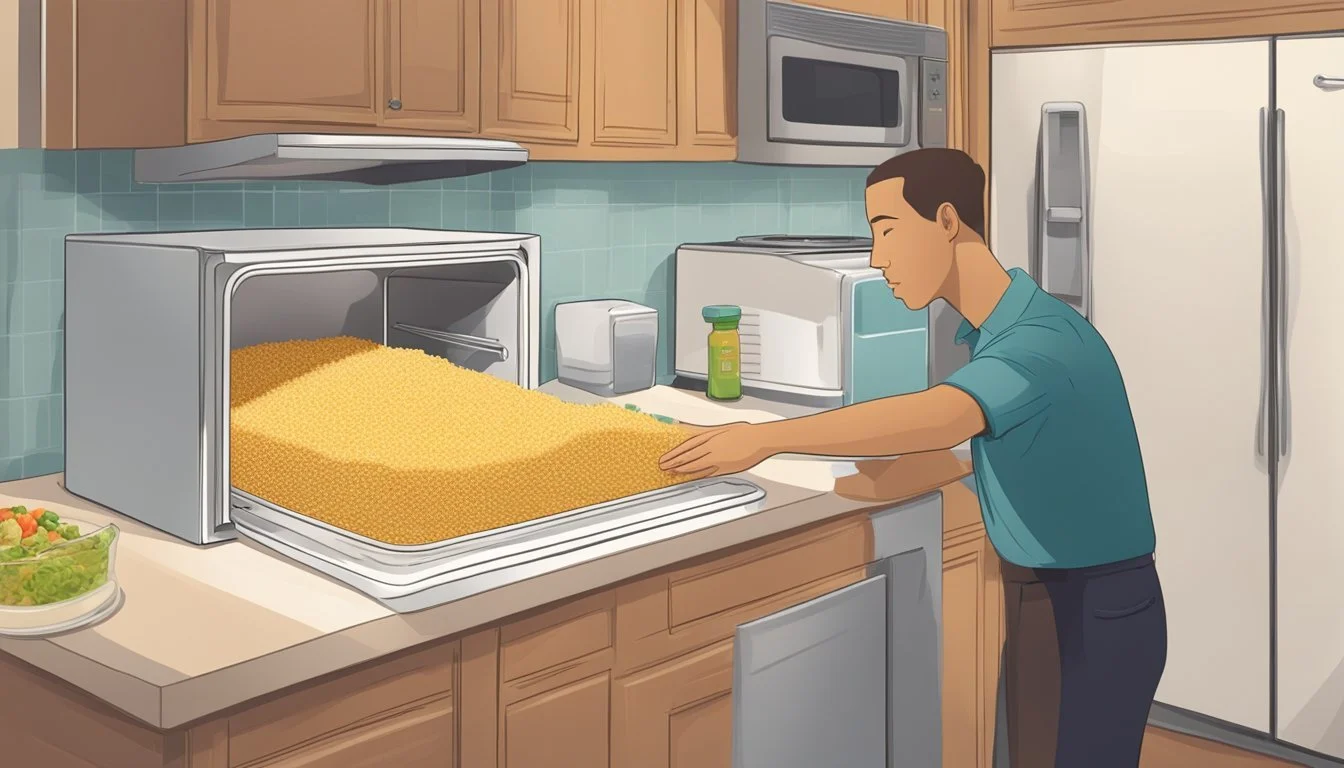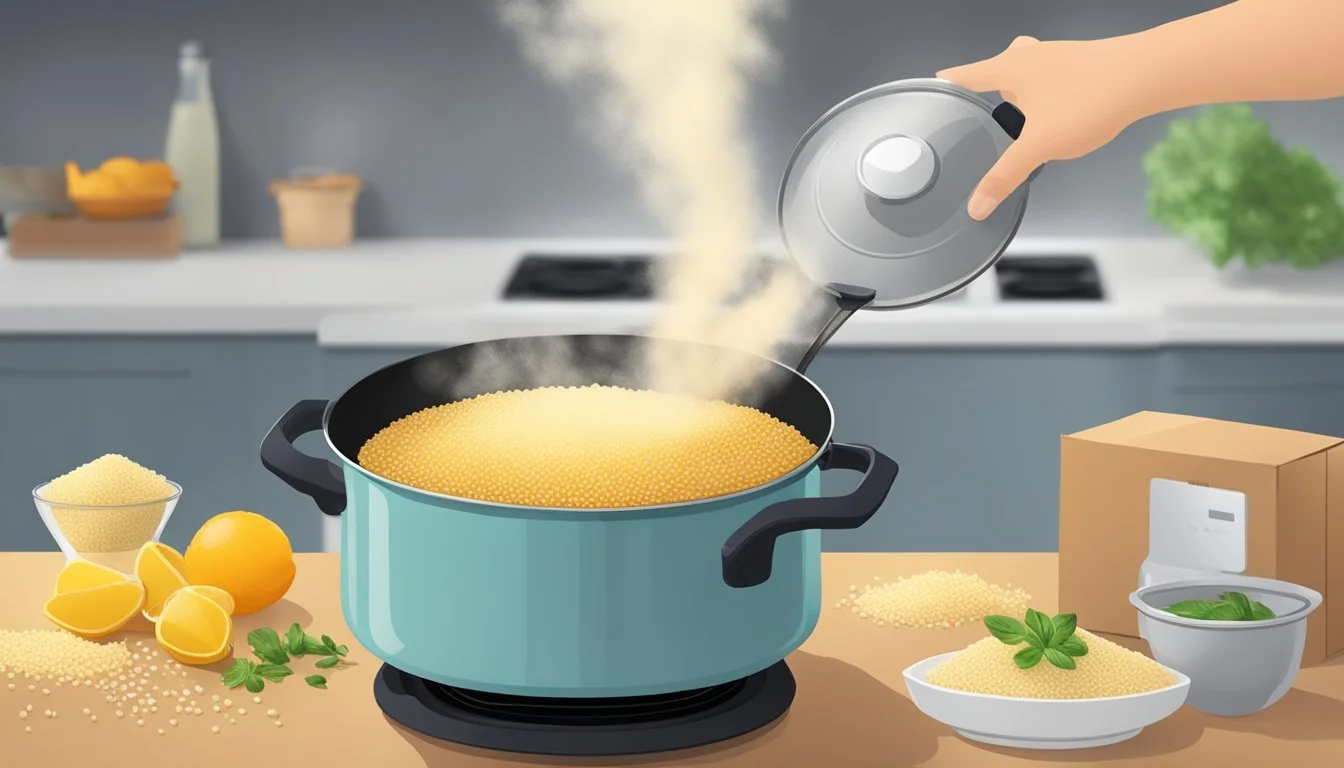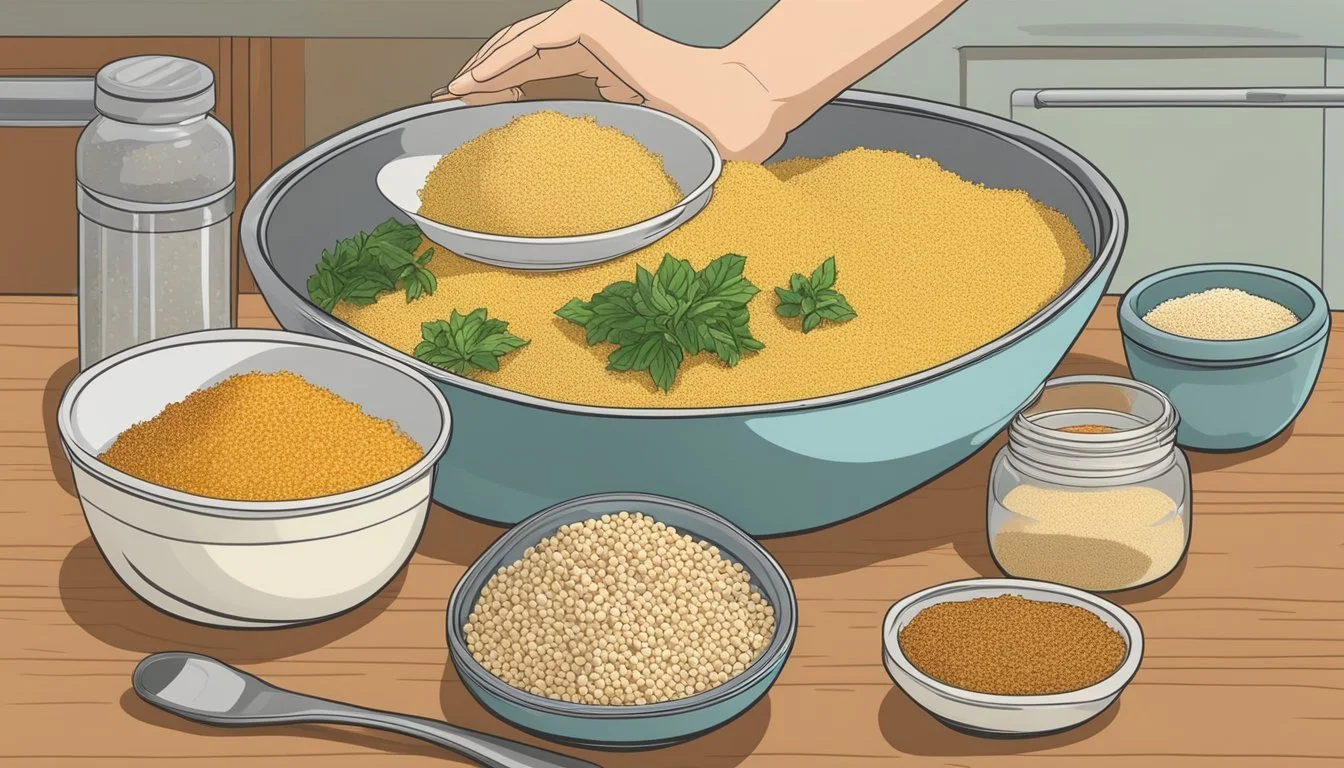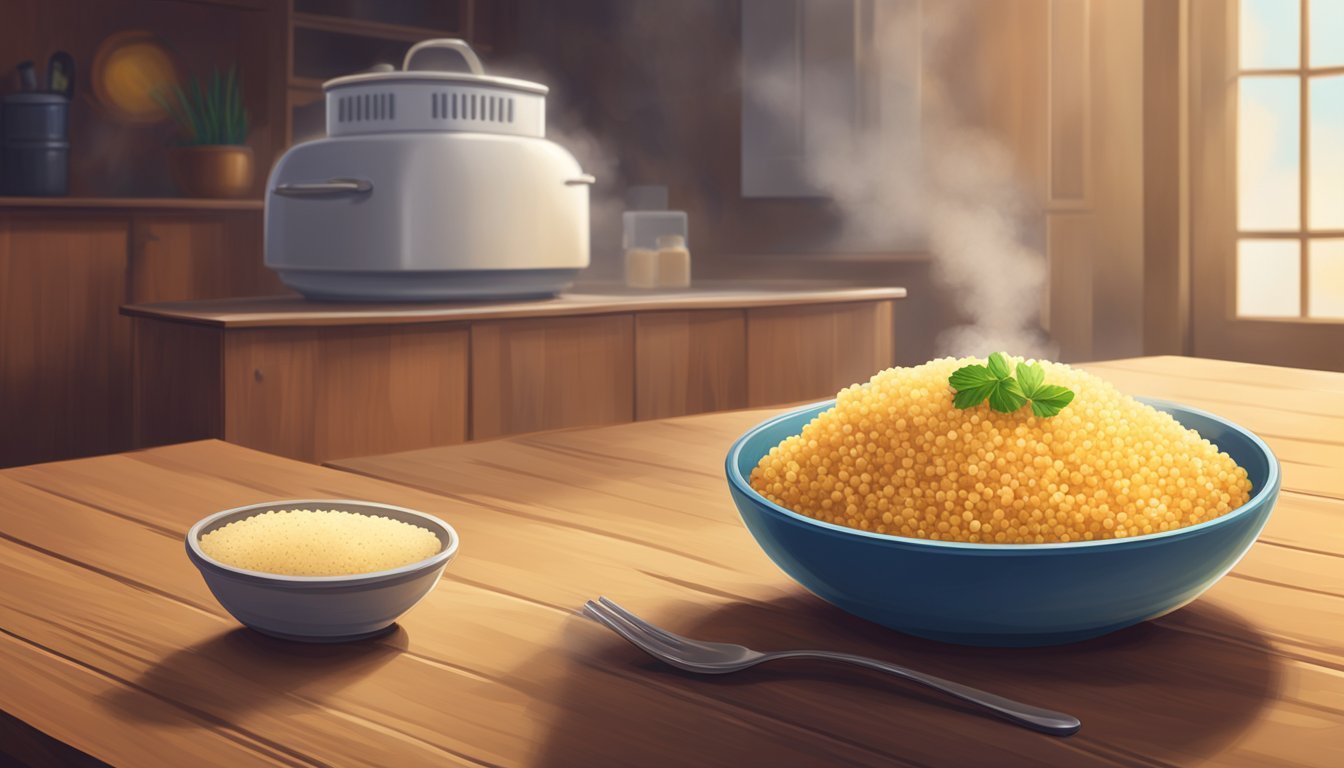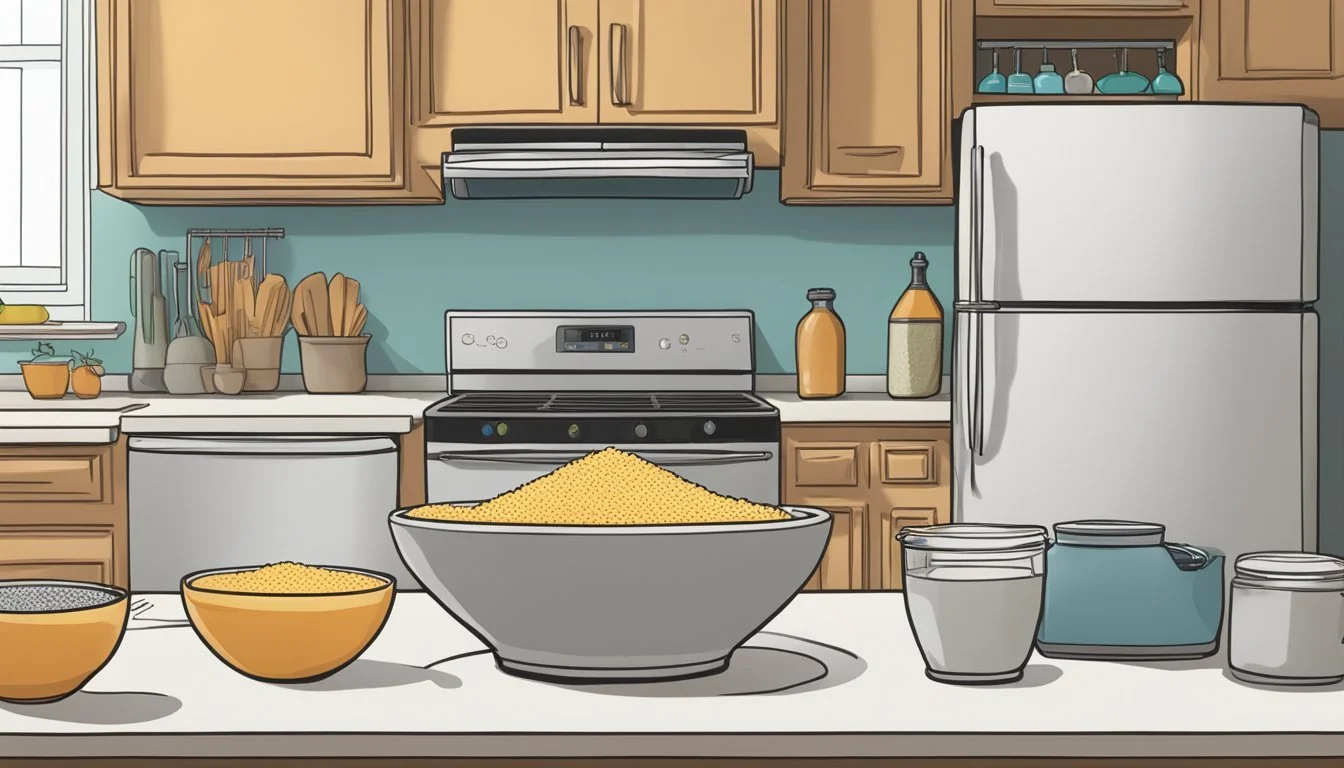Do I Have to Refrigerate Couscous?
Understanding Proper Storage Practices
Couscous, a staple grain in many cuisines, particularly North African, is often enjoyed for its versatility and quick cooking time. After cooking, many wonder whether couscous requires refrigeration to maintain its quality and safety. Refrigeration is indeed crucial for cooked couscous. When left at room temperature, bacteria can rapidly multiply, potentially leading to foodborne illnesses. Therefore, it's recommended to let the couscous cool to room temperature within two hours of cooking before placing it in a sealed container and refrigerating it.
In the fridge, cooked couscous remains fresh for approximately three to five days. Proper storage is key, and it involves using an airtight container to protect the couscous from moisture and odors which can compromise its taste and texture. If the couscous is stored correctly, it not only preserves the dish's safety but also its quality, allowing it to be reheated and enjoyed in various subsequent meals.
While couscous does not require refrigeration in its dry state, once cooked, the rules change. Even in a refrigerated environment, the shelf life of couscous should be monitored, and any signs of spoilage should be acknowledged. Thus, refrigeration is non-negotiable for cooked couscous to ensure it remains a safe and delightful addition to meals.
Understanding Couscous
In exploring whether couscous requires refrigeration, one must first recognize couscous as a versatile wheat-based staple, and understand its varieties which can affect its storage requirements.
What Is Couscous?
Couscous is a granular type of pasta that's traditionally made from semolina, which is coarse, purified wheat middlings of durum wheat. One can think of couscous as tiny beads that have a remarkable ability to absorb flavors and liquids, making it a popular ingredient in a myriad of dishes. It is prepared by steaming until it becomes fluffy and light in texture.
Types of Couscous
Different types of couscous are distinguished by their size and the type of wheat used:
Pearl Couscous: Also known as Israeli couscous or ptitim, it is larger in size and resembles small pearls, taking longer to cook and offering a chewier texture.
Whole Wheat Couscous: Made from whole wheat flour, it brings a higher nutritional profile with more fiber and tends to have a nuttier flavor.
Here's a table outlining the basic differences:
Type Size Texture Cooking Time Traditional Couscous Small Light Quick Pearl Couscous (Israeli Couscous) Large Chewy Longer Whole Wheat Couscous Small to Medium Firmer Moderate
One should store couscous properly to maintain its quality, which includes consideration of refrigeration, especially after it's cooked.
Cooking Couscous
When cooking couscous, precision in liquid-to-couscous ratio and proper seasoning are pivotal for achieving a fluffy and flavorful result. Here are specific techniques and seasoning enhancements to elevate the humble grain to a delicious dish.
Basic Couscous Cooking Techniques
The ideal liquid to couscous ratio is typically 1:1—meaning one cup of liquid per each cup of couscous. The liquid, usually water or broth, should be brought to a boil in a saucepan on the stovetop. Once boiling, the couscous is stirred in, removed from heat, and covered to allow it to absorb the liquid and swell, typically within five minutes.
For a more nuanced flavor, one can first toast the couscous in a dry or lightly oiled pan until it is golden brown, infusing a nutty essence. In other cases, especially with pearl couscous, toasting is recommended with a bit of olive oil before adding the boiling liquid. To ensure the couscous cooks evenly and becomes satisfactorily fluffy, stirring occasionally can be helpful. Should convenience dictate, couscous can also be cooked in a microwave using a microwave-safe dish and following similar liquid ratio measurements.
Seasoning and Flavor Enhancements
To prevent couscous from tasting bland, incorporating herbs, spices, and seasoning during the cooking process is essential. Cooking the couscous in stock or broth instead of water provides a rich base flavor. Adding a pinch of salt can help to bring out the other flavors incorporated into the dish. Moreover, one can create an infused cooking liquid by simmering herbs and spices in the liquid before adding the couscous.
After the couscous has absorbed all the liquid, fluffing it with a fork and mixing in additional ingredients such as chopped herbs or a drizzle of olive oil can enhance the flavor and texture. For a richer taste, a pat of butter or a spoonful of aromatic seasoning like cumin or coriander may be added. Finally, citrus zest or a splash of lemon juice can brighten the dish and add a refreshing twist.
Storing Couscous
Couscous, a versatile grain product, has different storage requirements depending on whether it is cooked or uncooked. Proper storage is essential to maintain its quality and safety for consumption.
Refrigerating Versus Pantry Storage
Uncooked couscous thrives in a cool, dry pantry, protected from moisture and heat. This storage method can extend its shelf life up to two years. However, cooked couscous requires refrigeration in a sealed container. Upon cooling to room temperature, typically within two hours of cooking, it should be placed in the fridge to prevent bacterial growth. The optimum fridge temperature for storing couscous is 35-40°F (1.6-4.4°C), and its shelf life in this environment is generally three to five days.
Freezing Cooked Couscous
Freezing cooked couscous is an alternative method to extend its usability. To freeze, ensure the couscous is evenly spread in an airtight container or a zip-lock freezer bag. This prevents ice crystals from forming and maintains texture integrity. Label the container with the storage date. Frozen cooked couscous can last for up to three months. When reheating, there is no need to thaw; simply reheat directly in the microwave or on the stovetop. If an odor emerges from the cooked couscous, it is advised to discard it, as this is a sign of spoilage.
Reheating Couscous
When it comes to reheating couscous, one has several methods at their disposal, each ensuring the dish remains flavorful and safe to consume.
Reheating Options
Microwave: Individuals can place the leftover couscous in a microwave-safe bowl and cover it with a damp paper towel to retain moisture. It is recommended to microwave the couscous for 1-2 minutes, stirring occasionally to promote even heating.
Oven: The oven method involves spreading couscous on a baking sheet and lightly covering with foil. Reheat at a moderate temperature, such as 350 degrees Fahrenheit, for around 10 minutes or until thoroughly warmed.
Stovetop: A skillet or saucepan can be used for reheating couscous on the stovetop. They should add a small amount of water or broth to prevent the grains from drying out and stir frequently to achieve an even temperature throughout.
Best Practices for Reheating Couscous
To ensure the quality and safety of reheated couscous, consumers should adhere to the following practices:
Temperature Control: Always reheat the couscous until it reaches an internal temperature of 165 degrees Fahrenheit to kill any potential bacteria.
Moisture Retention: Adding liquid, such as water or broth, when reheating on the stovetop or oven can help maintain the couscous's moisture.
Stirring: Stir the couscous occasionally during the reheating process to avoid uneven heating and to prevent clumping.
Health and Nutritional Information
When examining the health and nutritional information of couscous, it’s important to consider its rich nutritional profile and dietary implications for individuals with specific nutrition-related concerns such as gluten intolerance or following a vegetarian diet.
Couscous Nutrition Profile
Couscous, a pasta made from semolina flour, provides a source of carbohydrates with a small amount of fiber. It contains vitamins and minerals essential for health. Here is an overview of its nutrition in a typical one-cup serving - approximately 157 grams:
Carbohydrates: Couscous is predominantly composed of carbohydrates, which can provide quick energy.
Protein: It contains a moderate amount of protein, which is vital for tissue repair and muscle growth.
Fiber: Couscous provides a small amount of dietary fiber, necessary for digestive health.
Vitamins and Minerals:
Niacin: 6 mg
Vitamin B5: 0.6 mg
Thiamin: 0.3 mg
Vitamin B6
Folate
Manganese: 1.3 mg
Phosphorus: 294 mg
Copper: 0.4 mg
Magnesium: 76 mg
Iron
Zinc
Calcium
Potassium
Couscous does contain gluten, as it is made from wheat, and should be avoided by those with celiac disease or non-celiac gluten sensitivity.
Dietary Considerations
From a dietary standpoint, couscous can be included as part of a balanced diet for vegetarians, offering both protein and essential nutrients. However, it lacks the complete amino acid profile found in meat, so it should be complemented with other protein sources such as beans or lentils.
Vegetarian-Friendly: Couscous is suitable for a vegetarian diet and can be paired with various plant-based foods to create a complete meal.
Gluten Content: Individuals following a gluten-free diet should avoid couscous since it contains gluten.
Fat Content: Couscous itself is low in fat, making it a potential component for low-fat diet plans.
The information highlights couscous as a nutritious option, but one that requires careful consideration for those with particular dietary needs or restrictions.
Couscous in Cuisine
Couscous, a quick-cooking staple, is celebrated for its versatile nature, serving as a hearty base in Moroccan dishes and adapting to a range of flavors in various recipes. It is a cherished ingredient in both traditional and modern cuisine, offering a neutral palate that pairs well with a variety of ingredients.
Traditional Moroccan Couscous Dishes
In Moroccan cuisine, couscous is far more than a simple side dish; it's a cultural emblem. Typically steamed over a stew of meat and vegetables, Moroccan couscous is often the centerpiece of the meal, infused with rich Mediterranean flavors. Vegetables such as zucchini, carrots, and turnips are common in these stews, contributing both nutrition and taste. Friday Couscous, or Couscous Seffa, is a notable traditional dish usually made with chicken or lamb, array of vegetables, and sometimes legumes, highlighting the importance of couscous in Moroccan festivities and family gatherings.
Versatile Uses in Different Recipes
Couscous’ flexibility makes it a favorite across various recipes beyond just Moroccan stews. It is quick and easy to prepare, making it ideal for busy cooks. Couscous is often found in:
Salads: Tossed with Mediterranean flavors, such as lemon juice, olive oil, and herbs, couscous salad is a refreshing option for a light meal or side dish.
Side dishes: Simple and quick to make, couscous can be seasoned and served beside proteins like fish or chicken.
Soups and Stews: Couscous can act as a thickener and add substance to soups and stews, absorbing the flavors of the broth.
Whether used in a traditional tagine or as part of a modern, health-conscious salad, couscous remains a beloved component of both time-honored dishes and contemporary cuisine due to its adaptability and ease of preparation.
Seasonings and Add-ins
Enhancing couscous involves a careful selection of seasonings and add-ins that complement its subtle flavor. The right combination of spices, herbs, and fats can elevate this staple grain to a flavorful and aromatic dish.
Spice and Herb Pairings
For spices, couscous pairs well with cumin, turmeric, and paprika, which not only add a warm color but also infuse it with earthy and slightly sweet flavors. To enrich the dish with a fresh and vibrant taste, one might incorporate herbs such as parsley, cilantro, dill, and mint. Lemon zest or juice can add a refreshing citrus note that enhances these herbal flavors.
Cumin: a warm, earthy spice, commonly used in North African cuisine.
Turmeric: offers a bright yellow hue and a subtle, earthy flavor.
Paprika: adds a sweet and smoky taste.
Parsley: bright and slightly peppery in flavor.
Cilantro: adds a fresh and citrusy touch.
Dill: delicate and slightly grassy taste.
Mint: brings a cool and refreshing aroma.
Incorporating Fats and Vegetables
Incorporating fats such as extra virgin olive oil or butter can add richness and help to carry the flavors of herbs and spices throughout the couscous. Adding sautéed garlic or onion can provide a savory depth. For texture and a nutty flavor, one might consider adding toasted nuts to the mix.
Extra Virgin Olive Oil: Use as a cooking fat for its fruity flavor and health benefits.
Butter: Adds a creamy and indulgent quality to the couscous.
Garlic/Garlic Powder: Introduces a potent and slightly spicy flavor.
Onion: Offers a sweet and savory base note.
Combining these elements thoughtfully can create a couscous dish that is rich in flavor and visually appealing. Using quality ingredients like kosher salt to season enhances the natural taste of the couscous and add-ins.
Serving and Presentation
When serving couscous, ensuring a fluffy texture and enhancing the nutty flavor should be the main focus. Precision in dishing and thoughtful pairing with main courses allow couscous to shine on the plate.
Dishing and Garnishing
To maintain couscous's fluffy texture, it should be fluffed with a fork before serving. Gentle handling prevents it from becoming dense or clumpy. For garnishing, a sprinkling of lemon zest can add a fresh, citrusy note that complements the couscous's naturally nutty flavor. One may also consider adding chopped herbs like parsley or cilantro for color and fresh flavor.
Pairing with Main Courses
Couscous pairs beautifully with a variety of proteins. With chicken, its subtle taste complements the savory flavors, while with fish, its light texture doesn't overwhelm the delicate taste of the seafood. Consider the following pairings for an optimal dining experience:
Chicken: Serve couscous alongside roasted or grilled chicken, using the pan juices as a simple sauce.
Fish: Pair couscous with grilled or baked fish, perhaps seasoned with a blend of Mediterranean spices.
By paying attention to these pairing suggestions, couscous can enhance a main dish while also standing out as a star on the plate in its own right.
Couscous Alternatives
When exploring couscous alternatives, one should consider both the need for gluten-free options and the desire for whole grains. These alternatives offer a range of nutritional benefits and can cater to various dietary requirements while providing a similar texture or role in recipes as couscous.
Substituting Couscous in Recipes
In recipes that traditionally use couscous, rice is a common substitute. It provides a similar texture and can absorb flavors well, making it a versatile option in a variety of dishes. Another excellent alternative is quinoa, which bears a resemblance to couscous but boasts a higher nutritional value, complete with protein, fiber, and essential vitamins and minerals. When substituting, it's important to consider cooking times and water ratios, as they may differ from those of couscous.
For instance:
Substitute Water Ratio Cooking Time Rice 2:1 18-30 min Quinoa 2:1 15-20 min
Gluten-Free and Whole Grain Variations
Those requiring a gluten-free diet can opt for quinoa, which is naturally free from gluten and can serve as a nutritious replacement for couscous. Additionally, whole wheat couscous, although not gluten-free, is an alternative that offers more fiber and a denser nutrient profile compared to the regular variety. It can be an ideal choice for individuals seeking whole grain options.
In summary, when selecting a substitute for couscous:
Rice and quinoa are top choices for texture and nutritional value.
Gluten-free options include quinoa, while whole wheat couscous provides a whole grain alternative.
Adjustments to cooking times and water ratios should be made accordingly.
FAQs and Troubleshooting
This section provides answers to frequently asked questions and solutions for common issues encountered when cooking, storing, and reheating couscous.
Common Cooking Questions
When preparing couscous, fluffing is crucial once it's cooked. To fluff couscous, one should use a fork to gently separate the grains, which prevents it from becoming a dense or sticky mass. The ideal ratio often used is one part couscous to one part boiling water or broth.
Q: What's the best water to couscous ratio?
A: Use a 1:1 ratio of water to couscous.
Q: Can I use a frying pan to cook couscous?
A: While unconventional, couscous can be toasted in a frying pan before steaming to enhance flavor.
Storing and Reheating Issues
Couscous should be stored in the refrigerator if not consumed immediately to prevent bacterial growth. In terms of reheating, couscous can be safely reheated using various methods such as steaming, microwaving, or in a stovetop skillet.
Stovetop Method:
Add couscous to a pan with a small amount of water or broth.
Cover the pan and let the couscous steam for a few minutes.
Microwave Method:
Place couscous in a microwave-safe dish.
Cover with a damp paper towel to prevent drying out.
Heat on a high setting in short increments, stirring occasionally.
Reheating FAQs:
Question Answer How long does couscous last in the fridge? Typically, 3-5 days when stored in an airtight container. Can couscous be reheated more than once? It's not recommended to reheat couscous multiple times for food safety reasons. Is it safe to reheat couscous in a microwave? Yes, using a microwave is a quick and effective method.
When reheating, one should ensure the couscous has reached an internal temperature of 165°F to be considered safe to eat. It's important not to add too much liquid during the reheating process, as this can make the couscous soggy.
Purchasing and Brand Recommendations
When looking for couscous, consumers should focus on grain quality and brand reputation to ensure the best culinary experience. The choice of couscous can significantly influence the flavor and texture of the final dish.
Selecting the Right Couscous
While shopping for couscous, one should consider the type most suited to their recipe. Traditional couscous is tiny and often requires steaming, while the larger Israeli or pearl couscous has a chewier texture suitable for salads and heartier dishes. Couscous is primarily made from semolina flour, a key ingredient that contributes to its light and fluffy characteristics. For a richer taste, one might look for varieties that include Mediterranean spices, such as ground cumin, blended into the mix. This adds a depth of flavor synonymous with regional dishes.
Recommendations for Quality Brands
Several brands have established themselves as reliable sources for quality couscous:
Brand A: Known for their traditional couscous made with high-grade semolina flour, providing the perfect texture for an array of dishes.
Brand B: Offers a diverse range that includes both traditional and Israeli couscous, often incorporating Mediterranean spices for an authentic taste.
For those preferring the convenience of online shopping, many reputable online shops stock these recommended brands alongside a variety of other quality options. When purchasing couscous online, be sure to check customer reviews and ratings to ensure the brand's quality and consistency.

